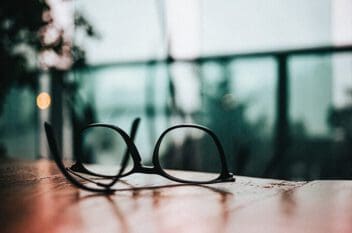Last Updated
Further Reading
- 8 Eyeglass Trends
- What People Did Before Glasses
- How to Find Your Pupillary Distance
- Cheap Sunglasses Dangers
- Anti-Reflective Coating
- How Much Should You Spend
- Photochromic & Transition Lenses
- Polarized vs. Regular Sunglasses
- Prescription Sunglasses
- Trifocals
- Medicaid for Glasses
- 5 Ways (or Places) to Donate
- How to Choose Glasses for Your Face Shape
- Prism Glasses for Double Vision
- What is Neurolens?
- Cleaning Eyeglasses
- Organizations That Help Provide Eyeglasses
- SPH & Prescription Meanings
- Aspheric Lenses
- Trivex Lenses
- Crizal Lenses
- HD Glasses Improve Your Vision
- Post-Cataract Sunglasses
- Glasses For Computer Vision Syndrome
- What Strength Glasses Are Right for You?
- How Often You Should Change Glasses
- Can Glasses Really Fix Colorblindness?
- Signs You May Need Glasses
- Macular Degeneration Glasses
- Glasses After Cataract Surgery
- Can Glasses Make Vision Worse?
- Adjusting to Your First Pair of Glasses
- High Index Lenses
- Blue Light Glasses
- What to Know About Your Eye Prescription
- Anti-Reflective Lens Options
- Prescription Sports Glasses for Children
- Glasses Online vs. In-Store
- Can Glasses Help With Night Driving?
- Progressive Glasses Lenses
- Best Glasses Lenses in 2020
- Glasses After LASIK
Where to Buy Safety Glasses (& Best Options in 2022)
Home / Everything About Glasses /
Last Updated
Safety glasses are a type of eyewear that provide extra protection around the eye for certain activities, such as welding or working with chemicals, that could be potentially hazardous to the eyes.
If you work in a physical job that poses risks to the eyes or participate in activities that do, you should wear safety glasses.
Table of Contents
Safety glasses are available in prescription and non-prescription varieties. Regular prescription glasses are not a replacement for prescription safety glasses.
Both prescription and non-prescription safety glasses are affordable and widely available. Many different local and online retailers sell all types of safety glasses.
With so many options for safety glasses out there, it is important to be sure you are getting quality protection. The Occupational Health and Safety Administration and the American National Standards Institute work together to ensure quality safety standards are met and properly defined.
Finding the right pair of safety glasses depends on the potentially hazardous activity you are engaging in and the level of protection you need. Utilizing eyewear selection guides, speaking with your employer, and consulting your eye care provider can help you select the right safety glasses.
What Are Safety Glasses?

Safety glasses, which are also referred to as protective eyewear or safety goggles, are special types of glasses worn by people doing certain activities that cause them to need extra protection around their eyes. If you work in an environment that poses a risk of foreign debris getting in your eyes, safety glasses can be worn as a shield to protect your eyes from irritation or injury.
Types of hazards that safety glasses are designed to protect the eyes from include:
- Flying debris.
- Splashes from dangerous chemicals.
- Impact from moving tools or machines.
- Sparks, heat, or intense lighting.
The frames of most safety glasses are made from nylon and have shields that wrap around the sides of the eyes. There are many different types of safety glasses you can use depending on the activity.
These types of lenses are commonly used in safety glasses:
- Clear
- Bifocal
- Anti-fog
- Tinted
- Indoor/outdoor
- Polarized
- Shooting
- Low-light
- Filtered
- Changeable
Who Should Wear Safety Glasses?

According to the Occupational Safety and Health Administration (OSHA), thousands of people become blinded every year because of work-related eye injuries that could have been prevented by wearing appropriate eye and face protection.
Anyone who works in a job or otherwise engages in activities that pose threats to the eyes should wear safety glasses. Employers are required by OSHA to provide eye and face protection to employees in order to shield against any potential chemical, environmental, radiological, or mechanical hazards.
People should wear safety glasses for these activities:
- Construction
- Manufacturing
- Mining
- Carpentry
- Auto repair
- Electrical work
- Pluming
- Welding
- Maintenance
- Laboratories
Prescription vs. Non-Prescription Safety Glasses
Safety glasses are for everyone — not just for people who already wear prescription glasses. Safety glasses can be purchased with or without prescription lenses.
It is important to note that regular glasses do not qualify as safety glasses. They are not built to sustain impact or to provide enough coverage to prevent harm to the eye.
The American Optometric Association (AOA) explains that the lenses and frames of safety glasses are much stronger than regular glasses. Prescription safety glasses tend to even be slightly thicker than non-prescription safety glasses due to the layers added to the lens to meet specific prescriptions.
If you have a prescription and prefer to wear contact lenses, they can safely be worn with non-prescription safety glasses. AOA supports workers who wish to wear contact lenses but explains that these workers must also wear appropriate safety glasses to prevent harm to the eye.
Where to Buy Safety Glasses
Prescription Safety Glasses
Safety glasses with prescription lenses are great for people who normally wear glasses. They allow you to see just like you normally would while also keeping your eyes safe on the job. Your eye doctor can be a great resource for buying prescription safety glasses. Ask if their office has any available or if they have recommendation for safe places to purchase prescription safety glasses.
Non-Prescription Safety Glasses
Non-prescription safety glasses are for people who do not wear glasses in their daily life.
In addition to basic glasses, some retailers also sell safety glasses that can easily be worn over prescription eyeglasses. This allows people who wear glasses to keep their eyes safe without having to invest in prescription safety glasses.
You can buy either of these types of glasses at any of the retailers below.
- Walmart: You can purchase safety glasses here for as little as $3. Sturdier versions that may offer you more protection sell for as much as $25. Some of the listed glasses can only be purchased online, but many are also sold in-store.
- Global Industrial: You can order safety glasses from Global Industrial starting at about $1.50. The most expensive glasses cost around $20. In some cases, you will need to purchase multiple pairs at a time to place an order.
- Amazon: You can get safety glasses from many different brands on Amazon for as little as $1. Many of them are eligible for free one-day or same-day delivery for Amazon Prime members, so this can be a good place to shop if you need your glasses on short notice.
How to Ensure You Are Getting Quality Glasses

OSHA and the American National Standards Institute (ANSI) work together to define and enforce safety standards for protective eyewear, among other products. The standard that you want to look for on any safety eyewear product you are considering is ANSI Z87.1.
ANSI Z87.1 certified safety glasses have met certain required standards that refer to the following:
- Design
- Performance specifications
- Marking of products
- Materials used
Eyewear specialists encourage everyone looking for safety glasses to only purchase products that have been ANSI Z87.1 certified. Through this certification, proper safety eyewear can then be selected based on the specific hazards being faced and which products have been approved for their use.
How to Select the Right Safety Glasses for You
To help you select the best safety glasses for your situation, the International Safety Equipment Association (ISEA) created the Eye and Face Protection Selection Tool. The goal of this guide is to help you understand the types of eye and face safety wear available, so you can select the best one based on the capabilities of the safety equipment and the hazards you may encounter.
The guide makes suggestions for what safety specifications to look for in your eyewear based on the following hazards:
- Impact: chipping, grinding, machining, masonry work, riveting, and sanding
- Heat: furnace operations, pouring, casting, hot dipping, gas cutting, and welding
- Chemical: liquids, acid and chemical handling, degreasing, and plating
- Dust: woodworking, buffing, and dusty conditions
- Optical radiation: infrared radiation, glare, ultraviolet radiation, and lasers
Potential safety equipment for the above activities includes glasses with side protection, safety goggles, and face shields.
Selecting the right safety eyewear depends on the level of protection you need. Use ISEA’s selection guide to help you determine what type of eye protection to look for, consult your employer, and speak with your eye care provider about the safest and most effective safety glasses for you.
Will I Need Safety Glasses After Eye Surgery?
You will still need to wear some sort of safety glasses after having eye surgery. This is because the purpose of safety glasses is to protect your eyes, not correct your vision.
However, you may be able to switch to non-prescription safety glasses if your newly corrected vision is good enough. 96% of patients who receive LASIK surgery end up with 20/20 vision or better, which is good enough to go without prescription glasses in most instances.
References
- ISEA Publishes ANSI/ISEA Z87.1 Eye and Face Protection Standard Update. International Safety Equipment Association.
- Eye and Face Protection. Occupational Safety and Health Administration: United States Department of Labor.
- Eye and Face Protection: Selection Tool. International Safety Equipment Association.
- Protecting Your Eyes at Work. American Optometric Association.
- Safety Glasses: Definition. Safeopedia.
- What Is the LASIK Success Rate? (August 2021). American Refractive Surgery Council.
The information provided on this page should not be used in place of information provided by a doctor or specialist. To learn more, read our Privacy Policy and Editorial Policy pages.
Further Reading
- 8 Eyeglass Trends
- What People Did Before Glasses
- How to Find Your Pupillary Distance
- Cheap Sunglasses Dangers
- Anti-Reflective Coating
- How Much Should You Spend
- Photochromic & Transition Lenses
- Polarized vs. Regular Sunglasses
- Prescription Sunglasses
- Trifocals
- Medicaid for Glasses
- 5 Ways (or Places) to Donate
- How to Choose Glasses for Your Face Shape
- Prism Glasses for Double Vision
- What is Neurolens?
- Cleaning Eyeglasses
- Organizations That Help Provide Eyeglasses
- SPH & Prescription Meanings
- Aspheric Lenses
- Trivex Lenses
- Crizal Lenses
- HD Glasses Improve Your Vision
- Post-Cataract Sunglasses
- Glasses For Computer Vision Syndrome
- What Strength Glasses Are Right for You?
- How Often You Should Change Glasses
- Can Glasses Really Fix Colorblindness?
- Signs You May Need Glasses
- Macular Degeneration Glasses
- Glasses After Cataract Surgery
- Can Glasses Make Vision Worse?
- Adjusting to Your First Pair of Glasses
- High Index Lenses
- Blue Light Glasses
- What to Know About Your Eye Prescription
- Anti-Reflective Lens Options
- Prescription Sports Glasses for Children
- Glasses Online vs. In-Store
- Can Glasses Help With Night Driving?
- Progressive Glasses Lenses
- Best Glasses Lenses in 2020
- Glasses After LASIK